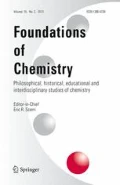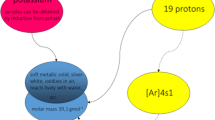Abstract
In this paper I investigate the relationship between vernacular kind terms and specialist scientific vocabularies. Elsewhere I have developed a defence of realism about the chemical elements as natural kinds. This defence depends on identifying the epistemic interests and theoretical conception of the elements that have suffused chemistry since the mid-eighteenth century. Because of this dependence, it is a discipline-specific defence, and would seem to entail important concessions to pluralism about natural kinds. I argue that making this kind of concession does not imply that vernacular kind terms have independent application conditions. Nor does it preclude us saying that chemists, with their particular epistemic interests, have discovered the underlying nature of water, the stuff that is named and thought about in accordance with the practical interests of everyday life. There are limits to pluralism.
Similar content being viewed by others
Notes
Note that Ellis does not use his conception of a natural kind for the purpose I have identified here, but the following remarks apply to any attempt to specify the notion of a natural kind through a priori constraints.
Caveat: this appearance may well be deceptive. Structure in organic chemistry appears to be a topological, rather than a geometrical notion (see Hendry 2010b, Section 1). What precisely molecular structure is, and even whether there are different notions of structure in different parts of chemistry, are important questions in need of further research.
Species pluralism is, or course, controversial: see Ereshefsky (2010, Section 3).
Perhaps that title is irresistible when one wishes to argue against essentialism about chemical kind terms: see Weisberg (2006).
One may also ask what grade of gold a particular gold ring is: any grade below 24-carat is, of course, a mixture with other metals. ‘This is gold’, said of a 9-carat gold ring, will be said of an object which is mainly non-gold.
References
Abbott, B.: A note on the nature of ‘water’. Mind 106, 311–319 (1997)
Aston, F.W., et al.: Report of the International Committee on Chemical Elements. J. Am. Chem. Soc. 45, 866–874 (1923)
Bird, A.: Discovering the essences of natural kinds. In: Beebee, H., Sabbarton-Leary, N. (eds.) The Semantics and Metaphysics of Natural Kinds, pp. 125–136. Routledge, New York (2010)
Bruzzaniti, G., Robotti, N.: The affirmation of the concept of isotopy and the birth of mass spectrography. Arch Internationales d’Histoires des Sci 39, 309–334 (1989)
Chomsky, N.: Language and nature. Mind 104, 1–61 (1995)
Devitt, M., Sterelny, K.: Language and Reality, 2nd edn. Blackwell, Oxford (1999)
Dupré, J.: Natural kinds and biological taxa. Philos Rev 90, 66–90 (1981)
Dupré, J.: The Disorder of Things. Harvard University Press, Cambridge, MA (1993)
Dupré, J.: Are whales fish? In: Medin, D.L., Atran, S. (eds.) Folkbiology. MIT Press, Cambridge, MA (1999)
Ellis, B.: The Philosophy of Nature: A Guide to the New Essentialism. Acumen, Chesham (2002)
Ellis, B.: The Metaphysics of Scientific Realism. Acumen, Durham (2009)
Ereshefsky, M.: Species. In: E. Zalta (ed.) The Stanford Encyclopedia of Philosophy (2010) URL: http://plato.stanford.edu/archives/spr2010/entries/species/
Feyerabend, P.: Explanation, reduction and empiricism. In: Feigl, H., Maxwell, G. (eds.) Scientific Explanation, Space and Time, pp. 28–97. University of Minneapolis Press, Minneapolis (1962)
Franks, F. (ed.) Water: A Comprehensive Treatise, vol 1–7. Plenum, New York (1972–1982)
Goodwin, W.: Mechanisms and chemical reaction. In: Hendry, R.F., Needham, P., Woody, A.I. (eds.) Handbook of the Philosophy of Science. Volume 6: Philosophy of Chemistry, pp. 310–327. Elsevier, Amsterdam (2011)
Gordin, M.: A Well-Ordered Thing: Dmitrii Mendeleev and the Shadow of the Periodic Table. Basic Books, New York (2004)
Hacking, I.: Putnam’s theory of natural kinds and their names is not the same as Kripke’s. Principia 11, 1–24 (2007)
Hendry, R.F.: Review of Natural Kinds and Conceptual Change by Joseph LaPorte. Philos. Writ. 27, 71–75 (2004)
Hendry, R.F.: Lavoisier and Mendeleev on the elements. Found. Chem. 7, 31–48 (2005)
Hendry, R.F.: Elements, compounds and other chemical kinds. Philos. Sci. 73, 864–875 (2006)
Hendry, R.F.: Microstructuralism: problems and prospects. In: Ruthenberg, K., van Brakel, J. (eds.) Stuff: The Nature of Chemical Substances, pp. 107–120. Königshausen und von Neumann, Würzburg (2008)
Hendry, R.F.: The elements and conceptual change. In: Beebee, Helen., Sabbarton-Leary, Nigel. (eds.) The Semantics and Metaphysics of Natural Kinds, pp. 137–158. Routledge, London (2010a)
Hendry, R.F.: The chemical bond: structure, energy and explanation. In: Dorato, Mauro., Rèdei, Miklós., Suárez, Mauricio. (eds.) EPSA Philosophical Issues in the Sciences: Launch of the European Philosophy of Science Association, pp. 117–127. Springer, Berlin (2010b)
Hendry, R.F.: Entropy and chemical substance. Philos. Sci. 77, 921–932 (2010c)
Hendry, R.F., Needham, P.: Le Poidevin on the reduction of chemistry. Br. J. Philos. Sci. 58, 339–353 (2007)
Klein, U.: Origin of the concept of chemical compound. Sci. Context 7, 163–204 (1994)
Klein, U., Lefèvre, W.: Materials in Eighteenth-Century Science: A Historical Ontology. MIT Press, Cambridge, MA (2007)
Kragh, Helge.: Conceptual changes in chemistry: the notion of a chemical element, ca. 1900–1925. Stud. Hist. Philos. Mod. Phys. 31B, 435–450 (2000)
Kuhn, T.S.: The Structure of Scientific Revolutions, 2nd edn. University of Chicago Press, Chicago (1970)
LaPorte, J.: Natural Kinds and Conceptual Change. Cambridge University Press, Cambridge (2004)
LaPorte, J.: Theoretical identity statements, their truth and their discovery. In: Beebee, H., Sabbarton-Leary, N. (eds.) The semantics and metaphysics of natural kinds, pp. 104–124. Routledge, London (2010)
Le Poidevin, R.: Missing elements and missing premises: a combinatorial argument for the ontological reduction of chemistry. Br. J. Philos. Sci. 56, 117–134 (2005)
Malt, B.: Water is not H2O. Cogn. Psychol. 27, 41–70 (1994)
Needham, P.: An Aristotelian theory of chemical substance. Log. Anal. Hist. Philos. 12, 149–164 (2009)
Putnam, H.: Mind, Language and Reality: Philosophical Papers, vol 2. Cambridge University Press, Cambridge (1975)
Putnam, H.: Is water necessarily H2O? In: Conant, J. (ed.) Realism with a Human Face, pp. 54–79. Harvard University Press, Cambridge, MA (1990)
Siegfried, R.: From Elements to Atoms: A History of Chemical Composition. American Philosophical Society, Philadelphia (2002)
Thurlow, K.J.: IUPAC Nomenclature part 1, organic. In: Thurlow, K.J. (ed.) Chemical Nomenclature, pp. 103–126. Kluwer, Dordrecht (1998)
Tobin, E.: Crosscutting natural kinds and the hierarchy thesis. In: Beebee, H., Sabbarton-Leary N. (eds.) The semantics and metaphysics of natural kinds, pp. 179–191. Routledge, London (2010)
van der Vet, P.: The debate between F.A. Paneth, G. von Hevesy and K. Fajans on the concept of chemical identity. Janus 92, 285–303 (1979)
Weisberg, M.: Water is not H2O. In: Baird, D., McIntyre, L., Scerri, E. (eds.) Philosophy of Chemistry: Synthesis of a New Discipline, pp. 337–345. Springer, New York (2006)
Acknowledgments
I would like to thank the Durham University Institute of Advanced Study for granting me a fellowship in the academic year 2009–2010 during which I researched this paper and another one (‘Science and Everyday Life: ‘Water vs. H2O’ Insights 3 (2010)) with which it overlaps. I would also like to thank an anonymous referee and participants in the conference ‘A Philosophy of Science Adequate to Chemistry’ at The University of Sydney for helpful comments.
Author information
Authors and Affiliations
Corresponding author
Rights and permissions
About this article
Cite this article
Hendry, R.F. Chemical substances and the limits of pluralism. Found Chem 14, 55–68 (2012). https://doi.org/10.1007/s10698-011-9145-6
Published:
Issue Date:
DOI: https://doi.org/10.1007/s10698-011-9145-6




